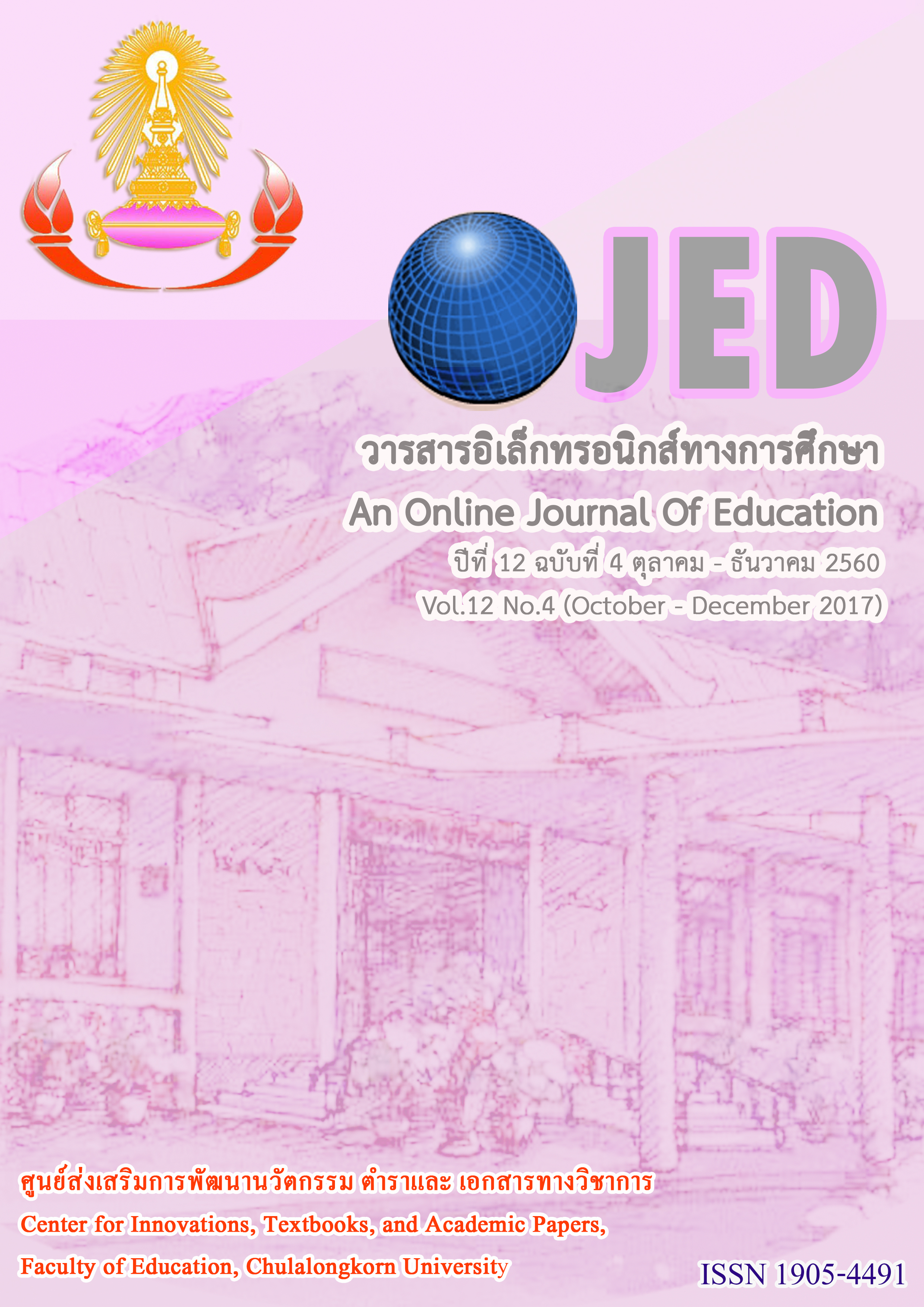การพัฒนาแบบวัดความฉลาดทางด้านสิ่งแวดล้อมสำหรับนักเรียนมัธยมศึกษาตอนต้น
Keywords:
องค์ประกอบ, ความฉลาดทางด้านสิ่งแวดล้อม, COMPONENTS, ENVIRONMENTAL LITERACYAbstract
การวิจัยครั้งนี้มีวัตถุประสงค์เพื่อ 1) ศึกษาลักษณะแบบวัดความฉลาดทางด้านสิ่งแวดล้อมสำหรับนักเรียนมัธยมศึกษาตอนต้น 2) ตรวจสอบคุณภาพในด้านความตรงและความเที่ยงของแบบวัดความฉลาดทางด้านสิ่งแวดล้อมสำหรับนักเรียนมัธยมศึกษาตอนต้น ผู้วิจัยดำเนินการศึกษาเอกสารและงานวิจัยที่เกี่ยวข้อง วิเคราะห์ข้อมูลจากนั้นสรุปเป็นองค์ประกอบสำคัญในการวัดความฉลาดทางด้านสิ่งแวดล้อม จากนั้นนำข้อมูลที่ได้มาสร้างเครื่องมือแบบวัดความฉลาดทางด้านสิ่งแวดล้อมสำหรับนักเรียนมัธยมศึกษาตอนต้น และนำไปตรวจสอบคุณภาพของแบบวัดด้านความตรงเชิงเนื้อหากับผู้เชี่ยวชาญจำนวน 6 ท่าน ตรวจสอบคุณภาพด้านความเที่ยงแบบสอดคล้องภายใน ตรวจสอบค่าอำนาจจำแนกและความยากง่าย โดยเก็บรวบรวมข้อมูลกับนักเรียนจำนวน 55 คน วิเคราะห์ข้อมูลโดยใช้ดัชนีความสอดคล้อง (IOC) และค่าสัมประสิทธิ์แอลฟาของครอนบาค
ผลการวิจัยสรุปได้ดังนี้ 1. บุคคลจะมีระดับความฉลาดทางด้านสิ่งแวดล้อมแตกต่างกันตามความแตกต่างของข้อมูลที่วัดได้จากองค์ประกอบ 3 องค์ประกอบ ได้แก่ 1) ความรู้ทางด้านสิ่งแวดล้อม 2) ความรู้สึกต่อสิ่งแวดล้อม และ 3) ความสามารถด้านสิ่งแวดล้อม 2. เครื่องมือแบบวัดความฉลาดทางด้านสิ่งแวดล้อมสำหรับนักเรียนมัธยมศึกษาตอนต้นมีลักษณะเป็นแบบทดสอบ 40 ข้อ และแบบมาตรประมาณค่า 5 ระดับ จำนวน 20 ข้อ มีความตรงเชิงเนื้อหาอยู่ในระดับที่เหมาะสม (ค่า IOC อยู่ระหว่าง 0.50 – 1.00) ข้อคำถามในแต่ละองค์ประกอบมีความสอดคล้องและสามารถวัดได้ในคุณลักษณะเดียวกัน โดยมีค่าความเที่ยงอยู่ระหว่าง 0.603 – 0.670 มีค่าอำนาจจำแนกและความยากง่ายในระดับที่เหมาะสมและบางข้อต้องปรับปรุงข้อคำถามสำหรับนำไปทดลองใช้เพื่อหาคุณภาพใหม่ก่อนนำไปใช้จริง
This research aims 1) to study the environmental literacy scale for lower secondary school students, and 2) to develop and validate a tool of environmental literacy for lower secondary school students. The data obtained from the review of the literature was used to develop an environmental literacy tool for lower secondary school students and verify the quality of the content validity of this tool by 6 experts. Verify the internal consistency reliabilities (Cronbach's a coefficients), discrimination indices and difficulty by gathering data from 55 students.
The result showed that: (1) Students have different levels of environmental literacy according to the different data that can be evaluated from three components including 1) environmental knowledge, 2) dispositions to the environment, and 3) environmental competencies; (2) the environmental literacy tool for the lower secondary school students was developed into a 40-point test and 5 levels rating scales with 20 items measuring environmental literacy of the students including content validity and are at an appropriate level (IOC is between 0.50 and 1.00) with appropriate internal consistency reliabilities (Cronbach's a coefficients range from 0.603 to 0.670). The discrimination rate and difficulty level are also at an appropriate level but some questions should be further developed.




